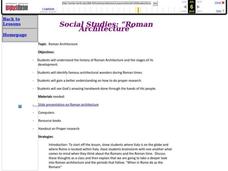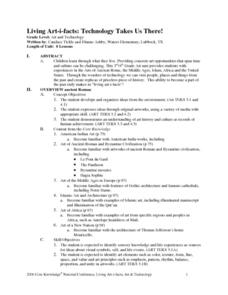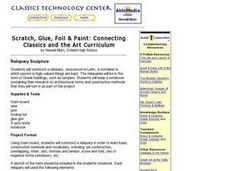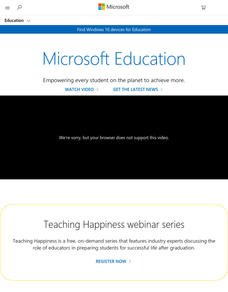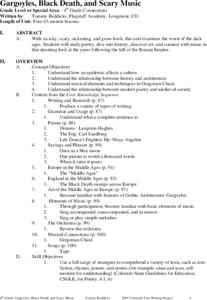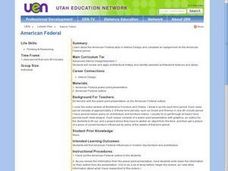Curated OER
Roman Archy
Third graders use Google Earth to examine Roman architecture. For this ancient Rome lesson, 3rd graders visit the noted URLs to look at examples of Roman architecture. Students work in teams to examine data about the structures.
Curated OER
Roman Architecture
Students examine Roman architecture. In this ancient Rome lesson, students discuss some attributes of Roman architecture prior to conducting research on the use of classical Roman architecture in modern buildings.
Curated OER
Living Art-i-facts: Technology Takes Us There!
Students create living artifacts dealing with different times and cultures. They explore Ancient Rome, the Middle Ages, Islam, Africa, and the United States.
Curated OER
Scratch, Glue, Foil & Paint: Connecting Classics and the Art Curriculum
Students construct a reliquary using foam board, researching basic Greek and Roman architecture and basic construction methods. They record their research and information in an architectural journal.
Curated OER
Technology and Medicine
Students watch a video and continue with research of Ancient Rome and the quest for knowledge. They form expert groups to study one aspect of life in Ancient Rome and share with the rest of the class.
Partnership for Educating Colorado Students
Mayan Mathematics and Architecture
Take young scholars on a trip through history with this unit on the mathematics and architecture of the Mayan civilization. Starting with a introduction to their base twenty number system and the symbols they used, this eight-lesson unit...
Curated OER
Friends, Romans, Countrymen...
Students research an important person or place from Ancient Roame and communicate their findings in a report that includes a map and illustration. Students may publish their reports online.
Curated OER
Travel Agent to the Ancient World
Students persuade others to visit ancient times. In this ancient civilizations lesson, students participate in a webquest that requires them to encourage others to visit ancient Greece, ancient Israel, Ancient Rome, ancient China,...
Curated OER
Friends, Romans, Countrymen...
Students research various facets of the Ancient Roman Empire including art and history. They write a research driven paper documenting the facet of the Roman Empire they have chosen.
Curated OER
A Tour of Rome Fit for an Emperor
Learners travel to Rome. In this geography skills activity, students explore famous places in Rome with Google Earth tools. Learners research the city of Rome and create touring brochures of the city from the perspectives of past...
BW Walch
Wondering About the New Seven (Man-Made) Wonders of the World
Who determines the Seven Wonders of the World, and what criteria is used to evaluate these locations? Discover the efforts to promote cultural diversity and preserve man-made monuments during the world's first-ever global vote in 2007 to...
Curated OER
Gothic Period
Learners write down information on their outline from the Gothic PPT presentation. Then, they sketch a chair from the Gothic time period by looking through in magazines to find a pictures of a piece of furniture or architectural detail...
Curated OER
Gargoyles, Black Death, and Scary Music
Students research the Dark Ages using books, the Internet, and other media. In this Dark Ages lesson plan, students study poetry, music, art, and the architecture of the Dark Ages.
Curated OER
Secrets of the Parthenon
Students take a closer look at the Parthenon. In this world monument lesson plan, students watch PBS video segments about the reconstruction of the Parthenon in Greece. Students research how the ancient Greeks built the structure and...
Curated OER
Every Building Tells a Story
Examine images from past that depict buildings and towns from their own communities, and compare images with photographs taken at present locations, interview local architect and compare role of 19th Century architect to 21st Century...
Curated OER
American Federal
Students review and apply architectural history and identify selected architectural features and styles of the Americal Federal time period. They write down the information on their outline from a PPT presentation included with...
Curated OER
Passport to Ancient Civilizations
Students complete a project about Ancient civilizations. In this ancient civilizations lesson, students explore the contributions made by ancient civilizations and research the scientific and technological achievements of ancient...
Curated OER
Mythology and Ancient Civilizations
Third graders examine ancient world civilizations and the mythologies they created to explain natural phenomena, as well as the writers and poets who wrote about the mythologies.
Curated OER
Wonders Of The World
Students explore wonders of the world. In this ancient civilizations lesson, students create criteria for naming ancient wonders of the world and then use the criteria to evaluate wonders of world since the original list. Students create...
Curated OER
Geometry of Democracy
Learners explore the architecture of New England by identifying geometric shapes. In this architectural lesson, students examine photographs of classic building architecture and use a transparency to trace geometric shapes they...
Curated OER
Introduction to the Byzantine Empire
Students research the founding of the Byzantine Empire in this instructional activity. They examine the geographic advantages of Constantinople, and the establishment of the empire. Finally, they compare the Byzantines, Romans, and...
Curated OER
Personalities of the Renaissance
Have the class interpret historical evidence presented in primary and secondary resources. They examine sources regarding architecture, art, exploration, government, literature, religion, and technology of the era. Then they use their...
Curated OER
Their Names Are Pricked
Students discuss areas of ambiguity in Julius Caesar and analyze the language as a tool to illustrate complex desires. In this Shakespeare lesson, students define subtext and use a neutral scene to act out subtext. Students create their...
Curated OER
Who Built the Pyramids?
Students examine the two theories on how the pyramids at Giza were built. They watch a video on pyramids, take notes, and write a five-paragraph essay on how they think the pyramids were constructed.

